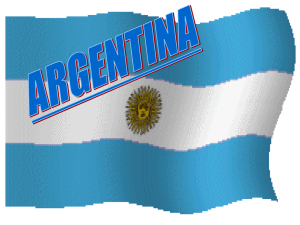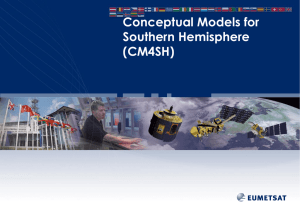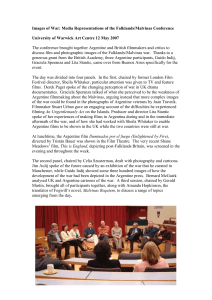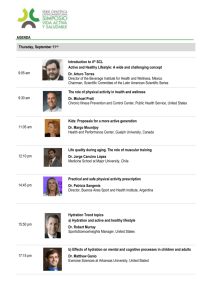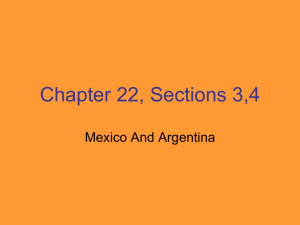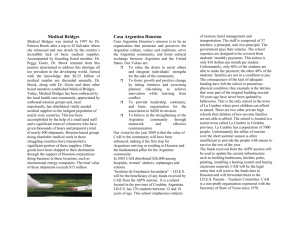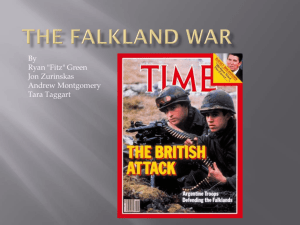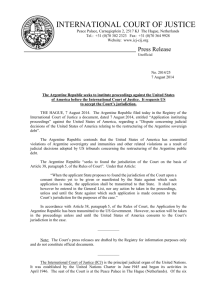Argentina - People Server at UNCW
advertisement
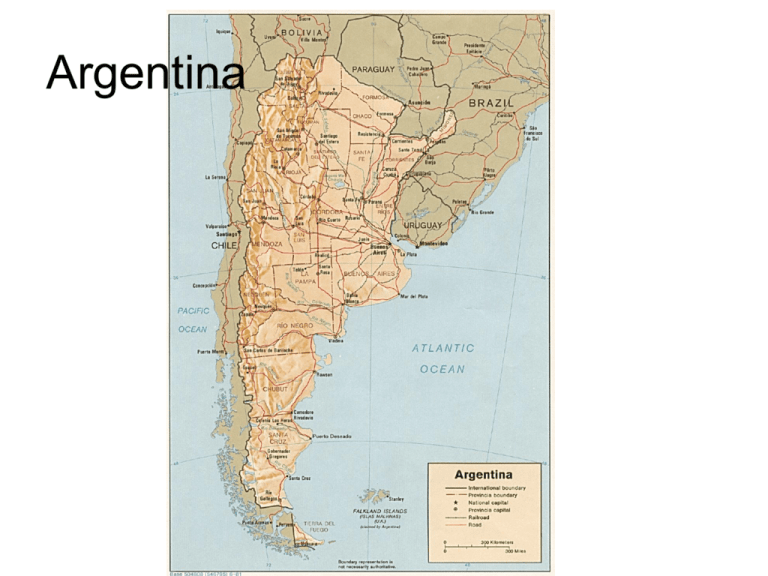
Argentina Argentina~Background Information • Official Name: The Argentine Republic • Population (2001): 36.02 million • Ethnic Groups: European 85%, mostly of Spanish or Italian descent. Mestizo, Armerindian or other non-white groups15% • Religion: 92% Roman Catholic, Protestant 2%, other 4%. • Language: Spanish • Education 10 years compulsory (Adult Literacy (2001) 97%.) The Argentine Republic • • • • • 2.8 million sq. miles 36.02 million pop. GDP $263 billion Per capita: $7,400 Growth: -4.5% • Presidential democracy – Nestor Kirchner • Bicameral Congress – Senate (72) – Chamber of Deputies (257) • Judiciary: Supreme Court • Administrative subdivisions: 23 provinces, one federal district (Buenos Aires). People • Descendants of Italian and Spanish immigrants. • Overwhelmingly Catholic with largest Jewish population in South America. • Indigenous population mainly in northern provinces. • Majority of the population urbanized, half considers itself middle class. History • 1516 Juan Diaz de Solias visits area of contemporary Argentina. • Spanish colony est. 1580 at site of Buenos Aires which becomes an important port. • 1816 independence declared – San Martin most important leader of the movement. • Post Spanish defeat civil conflict over future. • 1853 Constitution promulgated. Argentine Politics: Conflict and Charisma • Conservatives and Radicals were the dominant factions in Argentine politics from independence. – Conservatives – elite controlled, hierarchically ordered political system (ex: limited suffrage). – Radicals – fair elections/democratic institutions (Union Civica Radical) • Juan Peron emerges on national scene in military coup of 1943. • Peron wins election 1946. Military and Politics • In 1930s military begins a process of modernization and professionalization. • Divided on best political leadership for Argentina: – Different factions supported: oligarchy, semifascism, corporatism (hierarchical order based on function), became convinced it was best qualified to run government. 1940s • Antipathy to Allied powers. • Argentine military views neutrality as good for the economy. • Military impatient with corrupt, disorganized civilian politics. • Class consciousness emerges among workers (military sympathetic). Peronism • Corporatism with a difference – Base is the working class, industrialists, military – An interventionist role for the state in the economy • Populist message: promised promoting Argentine solutions while channeling material and psychological rewards to workers (previously denied). – Increased minimum wages – Encouraged strikes, stepped in to settle in favor of workers. – Reduced foreign influence in the economy – Nationalized railroads (GB constructed). – Initial results: 1946-50 GDP grew 5-12% annually. Post-Peron • Peron exiled in 1955 – Growing class conflict – Death of Evita (1953) – Loss of control (especially anti-clericalism) • Military stewardship until 1958 – Not effective in reversing economic decline – Political parties divided (strong anti-Peron) • 1958-62 transition, Frondizi administration – IMF program adopted: 25% cut in worker wages, 97% increase in income to beef industry – emphasis reversed from workers to capitalists. • 1966 military intervenes determined to restructure Argentine society. Military in Government • Unable to successfully restructure economy • Opposition develops • Clandestine torture, kidnapping on part of military – opposition groups engage in terror tactics. • Peron influencing system from (30 yr) exile. Returns to power in 1973 elections via Hector Campora a stand-in candidate. Onset of Dirty War • Peron and wife Isabel run as President/VP in 1973 (new elections). • Peron ticket wins – Peron dies in 1974. • Isabel unable to control the government. – – – – Turns on supporters Erratic changes in Cabinet Economy out of control Revolutionaries unchecked • Removed by coup in 1976 – military allowed the situation to worsen. The Dirty War • 1976-1980 (82) 10,000-30,000 disappeared. • Shows the ability of a well equipped government to put down guerrilla movements. • Military goal was to fundamentally alter nature of Argentine society. • Military expanded beyond government to social arenas (sports/charitable organizations). • Falkland/Malvinas conflict discredits military. Democratic Transition • 1983 elections Raul Alfonsin (UCR) Radical Party leader wins. (6 year term) – – – – Disappeared Economic stabilization Civilian control of armed forces Consolidating democratic institutions – Economic stabilization package less than successful – leaves office 6 months early. Carlos Menem • Peronist-Justicialist (Justicialist) Party • 1989 presidential election winner • Reversed the role of the state in Argentine economy (privatization). • Imposes peso-dollar parity. • Continued with efforts to resolve “los desaparacedos” situation. • 1995 wins re-election. • Large public sector debt problematic in eyes of international financial community. Fernando De la Rua • Radical Party candidate wins presidential election in 1999. • Raises taxes in attempt to deal with debt situation – chokes off domestic growth..intensifying the recession. – Economy tailspins inflation skyrockets, growth at a stop, government stops citizen access to banked monies. – Peso-dollar convertibility stops inflation but makes peso less competitive in export environment. – Chronic deficit made worse by continued IMF loaning • Asian financial crisis 98 – capital outflow – panic 11/01 • Riots – violence – De la Rua resigns in December 2001. President(s) • The Legislative Assembly moved to replace De la Rua with an interim and scheduled elections for within three months. • December 23-30, 2001 – Adolfo Rodriguez Saa – Continued violence, lack of support led to his 12/30 resignation. • January 1, 2002 – Eduardo Duhalde – Rising poverty, continued social unrest – government response has been to increase social programs; continue efforts at economic stabilization. President(s) • April 27, 2003 first round presidential elections: – – – – Menem (PJ) 24.3% of vote Nestor Kirchner (PJ) 22% Ricardo Murphy 16.4% Elisa Carrio 14.2% • Menem withdraws before runoff May 25 (polling shows overwhelming support for Kirchner). • Kirchner takes office May 25, 2003 Personalism vs Institutionalism • Argentina’s political history is dominated by personalities. • Institutional strength vis-à-vis individuals or organizations, such as the military is increasing but has not yet fully emerged. • Military remains independent of the civilian political system as opposed to subordinate to civilian rule. • Military does appear to be out of crisis political decisions – but is this because of institutional change or merely because it chooses to remain outside of these processes? • Economic growth/stability still not systematic. Kirchner • • • • Was Santa Cruz governor. Peronist-Justicialist Party. Wife is Senator Christina Fernandez de Kirchner Focused on increasing support beyond 22% in April 03 election. • Terms are 4 years and limited to one re-election. • Reforms include social efforts such as increasing the minimum wage, pensions, some governmental salaries. • Economic reforms include continuing.
